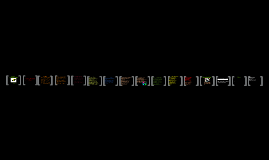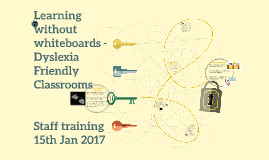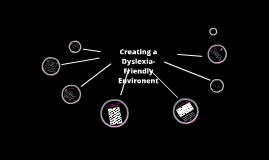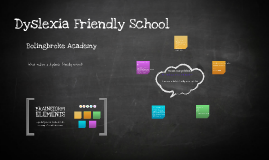Dyslexia Powerpoint
Transcript: Rights History I was, on the whole, considerably discouraged by my schooldays. I was not pleasant to feel oneself so completely outclassed and left behind at the beginning of the race." - Winston Churchill Famous Dyslexics It is the most common learning disability ( estimated that 4-7% pf people have some type). Dyslexics use both sides of their brain in order to do things that most non-dyslexics only use one side of their brain to perform (may have to use about six times the effort of non-dyslexics). The majority of dyslexics are left-handed. Treatment Can be inherited. Hearing disabilites when young ('glue ear') causes delay in phonemic awareness resulting in difficulty processing verbal language cues. Cranial trauma. Dietary deficiencies during pregnancy. Faulty migration of brain cells in left and frontal parts of brain (help control reading and writing). May have smaller magnocellular area of brain (ability to see moving images). Defining Dyslexia Letter reversals ("d" for "p") and the inability to write symbols in the correct sequence. Difficulty with sounds or groups of letters. May talk later than most children. Word reversals ("tip" for "pit"). Transpositions ("felt" and "left"). Inversions ("m" and "w" and "u" and "n"). Substitutions ("house" and "home"). 1968: "a disorder in children who, despite conventional classroom experience, fail to attain the language skills of reading, writing, and spelling commensurate with their intellectual abilities." (World Federation of Neurologists) Trouble paying attention (hyper). May feel dumb and worthless. Good long term memory. May complain of dizziness, headaches or stomach aches while reading. Dyslexics are by no means less intelligent than non-dyslexics, they merely learn slower in some subjects, or learn in different ways. Other Information Tom cruise, Whoopie Goldburg, Thomas Edison, Albert Einstein, Leonardo da Vinci, Muhammed Ali, Nolan Ryan, John F. Kennedy, George Washington and Henry Ford. DYSLEXIA (a learning disability) Causes 1925: Samuel Orton (American physchiatrist and neurologist) studies ambidextrous children and saw that they often times reversed letters. He called this condition strephosymbolia. 1936: The foundation of the Ordblind Institute was develope for word blind children. 1962: The Invalid Children's Aid Association on Word-Blindness or Specific Development Dyslexia conference was held (dyslexia was used to describe the loss of reading ability, due to brain lesions). Not much of an understanding of dyslexia until 1980 (National Institute of Health began research) There is no cure (once one is diagnosed, they will always have it), but one can learn to live with it and work through it. Very important to find it at an early age. People of all ages need the help of specially trained educators (teachers, tutors, therapists). Computer assisted learning (writing on the computer). Recorded books and tests. More time to finish tasks. More resources (help in taking notes). Famous dyslexic quotes. Retrieved from http://www.dyslexiclikeme.org/ History of Dyslexia. Retrieved from http://www.macalester.edu/academics/psychology/whathap/ubnrp/dyslexia/hist2.html Dyslexia Symptoms, Test and Treatment. Retrieved from http://www.dyslexiasymptoms.net Dyslexia. Retrieved from http://www.medicinenet.com/dyslexia/article.htm Childrens Health. Dyslexia Syptoms by Age: Children and Adults. Retrieved from http://children.webmd.com/tc/dyslexia-symptoms Dyslexia Basics. Retrieved from http://www.ldonline.org/article/Dyslexia_Basics NINDS Dyslexia Information Page. Retrieved from http://www.ninds.nih.gov/disorders/dyslexia/dyslexia.htm Research Types http://bcove.me/r635tl8k Protected from discrimination under the Individuals with Disabilities Education Act of 2004 (IDEA, Section 504 of the Rehabilitation Act of 1973, and the Americans With Disabilities Act (ADA), which also provide special services (education programs). The National Institute of Neurological Disorders and Strokes (NINDS) and the National Institute of Health (NIH) are focusing on biological and genetic research, and on the neurophysiological processes and cognitive functions having to do with reading ability. April 22, 2012 Characteristics/ Symptoms http://www.lexercise.com/dyslexia-services/screen-your-child/ By: Ryan Hart Professor: Mrs. Manning Osborn 1860: Adloph Kussmal (a german physician) stated that the ability to read may be a separate function of the brain, calling it alexia "word blindness." 1891: Dr. Dejerne studied a patient who had a cerebral vascular accident, who lost his ability to write and comprehend. 1895: James Hinshelwood (a British optic surgeon) studied a boy who had trouble reading and writing, diagnosing him with congenital word blindness and stating that cerebral damage and birth injuries may have played a role. "Dyslexia is termed as a learning disability that hinders an individual's ability to spell, read, write and sometimes even speak." (National Institute of

















